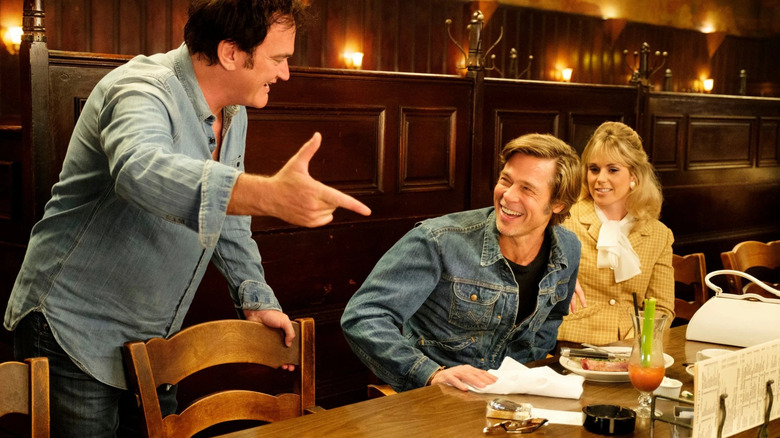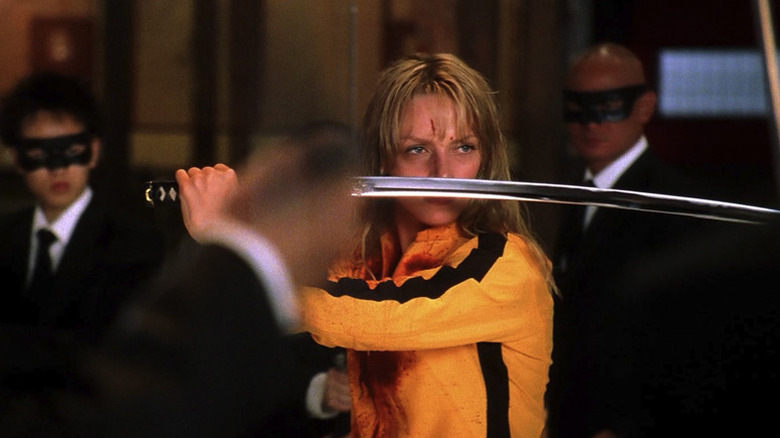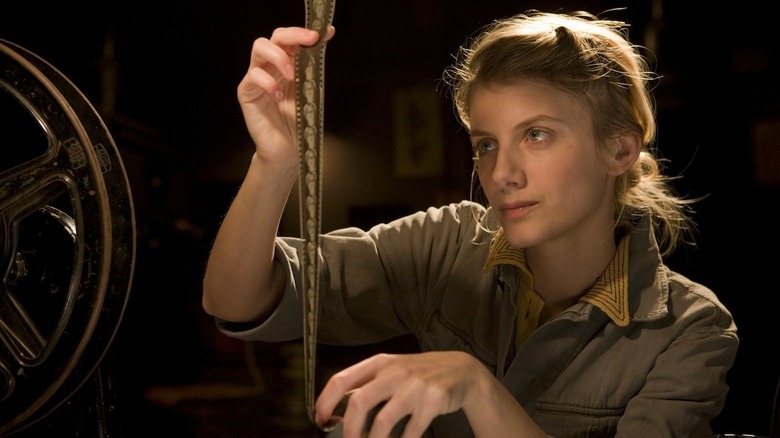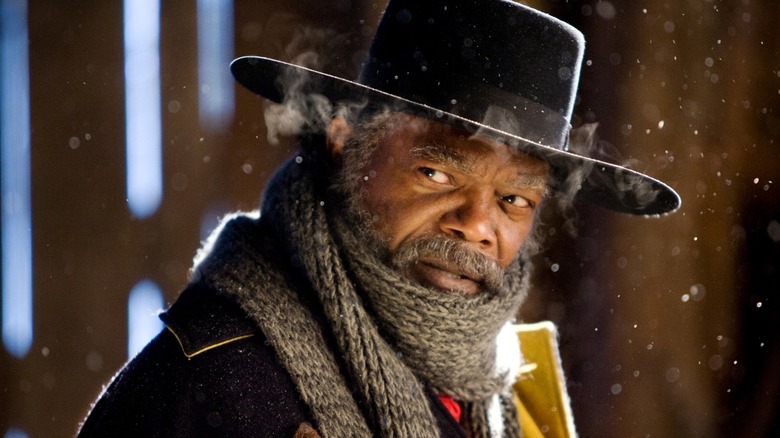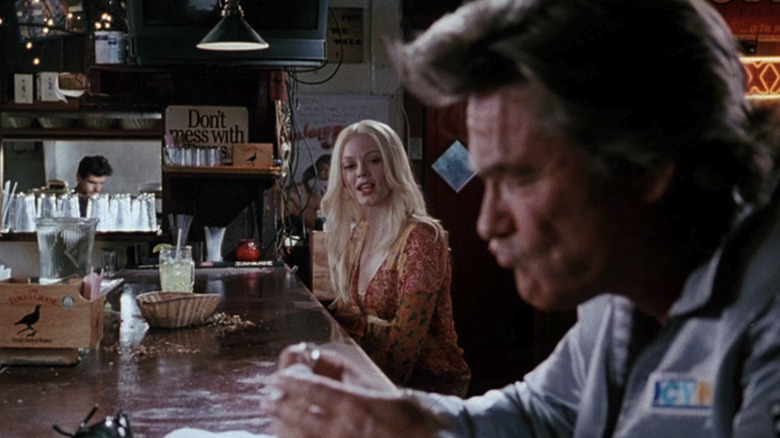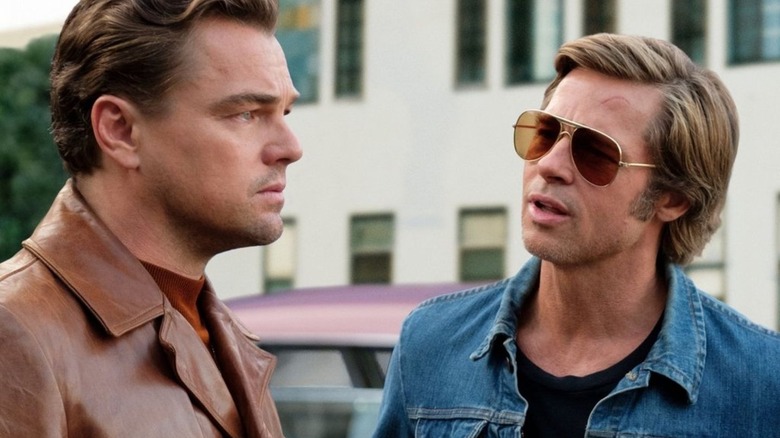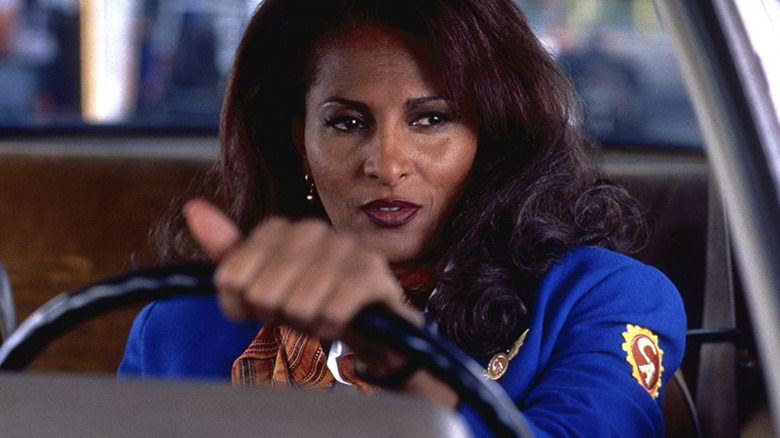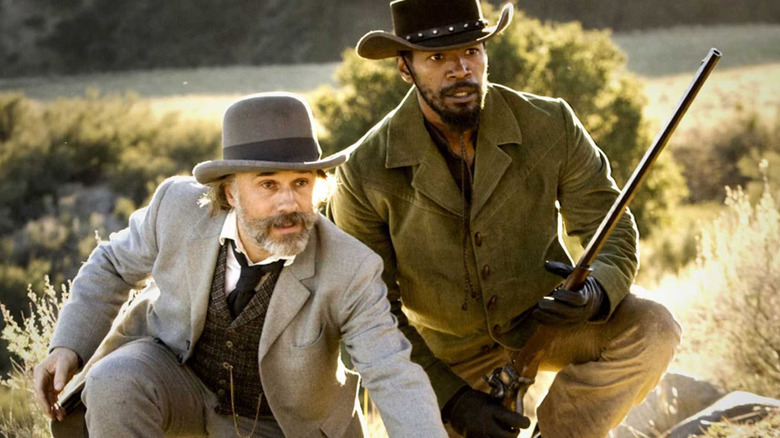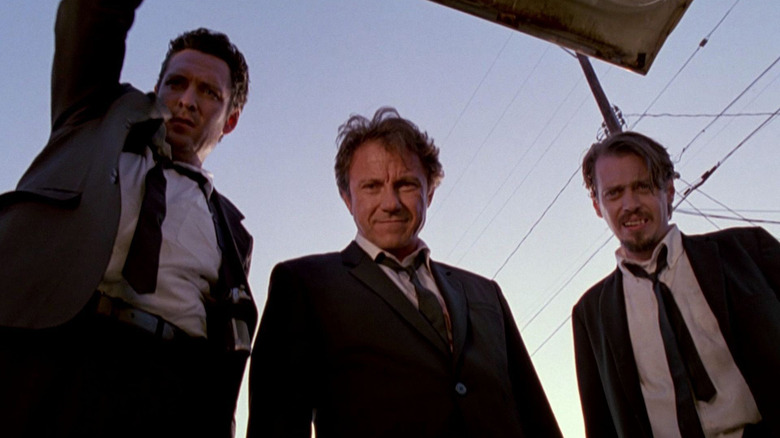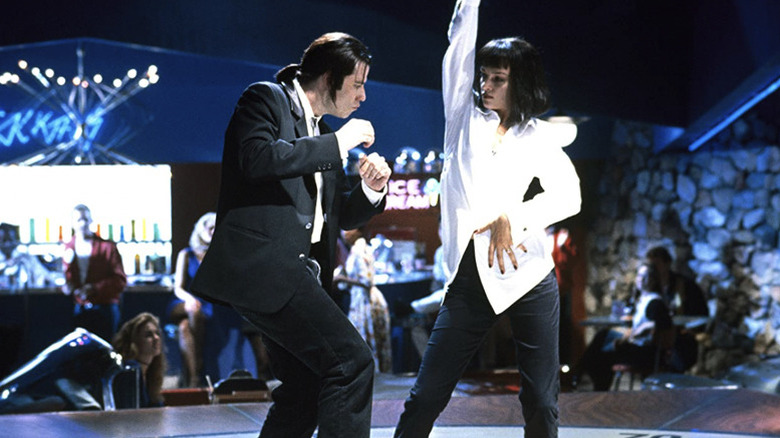Quentin Tarantino's Movies Ranked By Their Excellent Soundtracks
Writer and director Quentin Tarantino is known for his inventive style shaped by his cinematic obsessions. One of his signature trademarks (besides over-the-top violence, non-linear stories, and dark humor) is the unique use of soundtrack music — both traditional scores from other movies, and the popular genres of rock and roll and pop. He rarely uses an original score. Tarantino understands how important songs are to a film's structure, using them to emphasize a particular theme, voice characters' inner thoughts and emotions, or evoke a specific mood. Songs are often the most memorable element of Tarantino's films.
This list ranks Tarantino's movies based on their excellent soundtracks — specifically, how well the songs function in the story, how they impact the visuals, and their cultural resonance. I compiled this list based on Tarantino's view of his canon as nine complete movies and plans to retire after his tenth film, combining the "Kill Bill" series into one. The writer/director's films are not only a visual feast for the eyes, but a sonic one for the ears. As Tarantino explains in "The Tarantino Collection," songs are his biggest inspirations for a project:
"One of the things I do when I am starting a movie, when I'm writing a movie or when I have an idea for a film is, I go through my record collection and just start playing songs, trying to find the personality of the movie, find the spirit of the movie ... then, 'boom,' eventually I'll hit one, two or three songs, or one song in particular, 'Oh, this will be a great opening credit song.'"
All right ramblers, let's get ramblin'.
9. Kill Bill Vols. 1 and 2
The "Kill Bill" soundtracks are very eclectic, featuring everything from RZA's edgy score, contemporary Latin songs, Ennio Morricone, and country music by Johnny Cash and Charlie Feathers. For "Kill Bill: Vol. 2," Tarantino's friend and collaborator Robert Rodriguez creates an exciting soundscape by mixing electronic sounds with a traditional orchestral score. Both soundtracks have a wild, brassy energy that fits the film's gory action sequences with intricate stunts.
Morricone's classic western instrumentals are tense and steady, providing a heroic backdrop for The Bride and her quest for vengeance. The film starts with a literal bang in the opening scene set to Nancy Sinatra's seductive "Bang, Bang (My Baby Shot Me Down)." One of the most memorable soundtrack moments is "Woo Hoo" by the 5. 6. 7. 8's in "Kill Bill: Vol. 1." Tarantino juxtaposes the quirky, fast-paced song against a blood-soaked pursuit where The Bride tracks down O-Ren in the House of Blue Leaves to create a thrilling action sequence. The "Kill Bill" movies have a mixed soundtrack that reflects its unique blend of the kung fu, western, and grindhouse genres.
8. Inglorious Basterds
In his historical vengeance film "Inglourious Basterds," Tarantino uses lots of original scores from period movies, particularly by Ennio Morricone. His harrowing, grandiose composition "The Mountain" from "The Secret of Sahara" overlays Shoshana's terrified flee from her hiding place. The melodic, string-infused "Un Amico" covers her tragic ending after her triumph against Hitler and his soldiers. '"Il Merciano," with its whistles and castanets, adds a spaghetti western genre flavor to the World War II drama. All of the songs have a rebellious bravado and intensity that fits with the rousing story of agents trying to overthrow the Nazis.
Morricone's instrumentals are the majority of the soundtrack, with the notable exception of David Bowie's deep-throated "Cat People (Putting Out Fire)" during Shoshana's determined preparation for her fiery retribution at the movie premiere. Bowie's seductive croon and the pounding drums motivate Shoshana as she dresses in bloody red, gets her gun, and stares in the mirror with vindictive eyes. The use of popular music doesn't happen often in "Inglourious Basterds," allowing this badass scene to shine. Tarantino breaks from orchestral music during this pivotal moment in order to build audience anticipation and excitement for the completion of Shoshana's mission, creating one of the most memorable musical scenes in his filmography.
7. The Hateful Eight
"The Hateful Eight" was the first Tarantino movie to feature a complete instrumental score. The esteemed Ennio Morricone won an Academy Award for his first western score in over 30 years. Tarantino's frosty western features a group of mean-spirited characters seeking shelter in the warmth of Minnie's Haberdashery from a life-threatening blizzard. As we wrote in a piece earlier this year, "Intense verbal sparring, psychological torture, and bloody shootouts ensue during their confinement. The ensemble's selfishness and deception is revolting." It is one of the darkest films in Tarantino's filmography.
There are none of Morricone's famous whistling sounds in this score. Instead, Morricone uses simple melodies, drawn-out brass notes, and ominous, taut strings to evoke the film's chilly atmosphere. It makes sense that part of the menacing music came from unused arrangements for John Carpenter's "The Thing." Morricone uses dissonant sounds to create a bleak soundtrack that perfectly encapsulates the hazardous weather and the characters' cruelty.
6. Death Proof
The soundtrack of "Death Proof," with songs like "Jeepster" by T. Rex, has a carefree tone that mirrors the attitudes of the daredevil leading ladies looking for a good time (as seen in the incredible stunts with real life danger, like actress Zoë Bell on the hood of a speeding car).
The passionate "Baby It's You" by Toni Smith and smooth "Staggolee" by Pacific Gas & Electric brings out the sexual tension between the characters. The girls' carefree jamming to Dave Dee's bouncy "Hold Tight" before the repeated shots of the bloody, flesh-tearing car crash is an unsettling juxtaposition. But what leaves a lasting impression is the sensual blues song "Down in Mexico" by The Coasters. Echoing the nostalgic lyrics that describe a girl dancing wildly with the song's narrator, Arlene uses the saxophone-laden ballad to accompany her manipulative lap dance.
April March's sweet-voiced "Chick Habit" is the abrupt closing song after the girls celebrate the violent death of the misogynistic stuntman. With its playful instrumentals and high-pitched vocals, it has a quirky, girlish style that brings out the film's seemingly feminist themes of women who battle the patriarchy. "Death Proof" is an unsung Tarantino classic with a soundtrack that has a genuine sense of time and place which, along with the grainy visuals, brings the audience back in time to the reign of 1970s female-driven sexplotiation films and grindhouse cinema.
5. Once Upon a Time in Hollywood
"Once Upon a Time...in Hollywood" is one of Tarantino's biggest soundtracks, featuring 31 songs, and the most effervescent. Songs such as "Treat Her Right" by Roy Head and the Traits, "Son of a Lovin' Man" by the Buchannan Brothers, "Mrs. Robinson" by Simon & Garfunkel, and "Good Thing" by Paul Revere and the Raiders have a buoyancy that corresponds with the film's sweet, nostalgic aesthetic. On the flip side, the intense "You Keep Me Hangin' On" by Vanilla Fudge has an aggressive energy in the cracking drums and whining vocals that adds chaos to the fight against the Manson family during the climax.
Tarantino uses his lighthearted soundtrack, pulled from California commercial radio, to immerse the viewer in a romanticized version of late 1960s. "Within the 1969 of Hollywood, these songs were still fresh, often promoting a sense of optimism that was indicative of an era that still held onto hope the world was going to be a better place, that the good guys would win, and that hitchhikers could be picked up with impunity," /Film wrote in 2019. The frothy tunes are perfect for the characters to listen to while cruising down the Hollywood strip in this poignant fairytale.
4. Jackie Brown
Considered by many to be Tarantino's "best and most underrated movie," "Jackie Brown" features one of his greatest soundtracks. Bobby Womack's gritty and propulsive "Across 110th Street" from the 1972 film of the same name underscores the opening credits that follow Jackie Brown through LAX. The song introduces Tarantino's film as a homage to 1970s blaxploitation films such as "Coffy" or "Foxy Brown," also starring Pam Grier. Tarantino honors this subgenre throughout "Jackie Brown" by assembling a soundtrack that features soul classics such as "Who Is He (And What Is He to You?)" by Bill Withers, "Inside My Love" by Minnie Riperton, and "My Touch of Madness" by Jermaine Jackson.
/Film previously mused that "Jackie Brown" features similar nostalgic themes and musical cues as "Once Upon a Time In...Hollywood" because Jackie listens to "songs from back in the day, her healthy obsession with the vintage and forgotten Delfonics perfectly encapsulating a woman whose time may be passing her by." In the final scene, Jackie sings along to "Across 110th Street" while driving. Womack's powerful song speaks for Jackie as someone who is also looking for a better way of life and does whatever she can to survive. "Jackie Brown" features bold, emotional songs that encapsulate the title character's strength and intelligence.
3. Django Unchained
The soundtrack of "Django Unchained" is just as ferocious as the protagonist. The driving songs motivate Django as he journeys with a German bounty hunter to the Candyland plantation to find his long-lost wife. Tarantino homages spaghetti westerns by including Morricone's classic scores with castanets, whistles, and acoustic guitars on songs like "The Braying Mule." The easygoing country tune "I Got a Name" by Jim Croce is a pleasant backdrop to Django and Dr. King Schultz's travels across the beautiful western landscapes. The song also holds special meaning to Django, whose name symbolizes emancipation in a world where he is only seen as one of many slaves and is constantly referred to as "boy" or other racial epithets.
Tarantino uses other anachronistic music to highlight Black musicians, specifically in the hip-hop and rap genres. Rick Ross' raw, justice-seeking anthem "100 Black Coffins" has a western tone with its whistling sounds. Written from Django's perspective, he condemns the horrors of the slave trade and vows to send the abusive white men to hell. It's the perfect song to underscore Django's tenacity.
The velvet-voiced John Legend sings "Who Did That To You?", a triumphant blues song that takes place during one of the most powerful moments of the film where Django rides to Candyland to fight for his wife. The thrilling shootout at the plantation, with classic over-the-top Tarantino blood splatter, features the brazen mash-up "Unchained (The Payback/Untouchable)" by James Brown and 2Pac that matches the scene's cathartic fury. Much like Jamie Foxx's fantastic performance as the formidable Black cowboy, these songs take viewers on an emotional journey that deftly balances humor and edginess while also articulating Django's quest for freedom.
2. Reservoir Dogs
Quentin Tarantino's breakout movie "Reservoir Dogs" structures the entire film, which is set across one weekend, around the deadpan voice of Steven Wright as a DJ hosting a radio station show called "K-Billy's Super Sounds of the 70s." Period songs such as Blue Swede's "Hooked on a Feeling" and Joe Tex's "I Gotcha" have a loose vibe that juxtaposes the gripping tensions of a heist that goes wrong. George Baker Selection's slick "Little Green Bag" accompanies the slow-motion opening scene of the crew strutting in their suits and grinning as if they are the coolest guys in the world.
The most famous use of soundtrack in "Reservoir Dogs" is "Stuck in the Middle with You" by Stealers Wheel. The juxtaposition of such a bubbly pop song over a torture scene is disturbing, particularly because of Mr. Blonde's flashy dancing and the joy he takes in such a sadistic, drawn-out act of violence. "Reservoir Dogs" established early how important soundtracks are to Quentin Tarantino's movies, and "Stuck in the Middle with You" a great example of how a perfect use of soundtrack can become the centerpiece of a film.
1. Pulp Fiction
Tarantino's masterwork "Pulp Fiction" cements popular music as a quintessential part of his work. In the book "Quentin Tarantino: The Cinema of Cool," the writer and director describes "Pulp Fiction" as a rock and roll version of a spaghetti western, with an enjoyable grab bag of rock and roll, surf music, soul, and pop classics serving as his version of Ennio Morricone. The well-rounded soundtrack features a host of artists such as Al Green, Dusty Springfield, and Ricky Nelson. There are countless memorable scenes paired with songs in "Pulp Fiction," such as Vincent Vega and Mia Wallace doing the twist to Chuck Berry's bopping "You Never Can Tell," or Mia dancing wildly to Neil Diamond's sultry "Girl, You'll Be a Woman Soon."
Tarantino's indelible use of soundtrack is immediately made known in the opening scene when the frenetic bass line of Dick Dale's "Misirlou" kicks in after Honey Bunny and Pumpkin pull out their guns at a restaurant. The zany instrumental song establishes "Pulp Fiction" as an offbeat, chaotic journey that ricochets through several different plotlines.
When we hear the sound of the radio turning to a different song, crackling until the disco hit "Jungle Boogie" by Kool & the Gang starts to play in Vince and Jules' car, we understand that music is propelling these characters through this twisted story of intrigue and violence. "Pulp Fiction" establishes how, in Tarantino movies, songs are never just a part of the moment — they are the moment.
